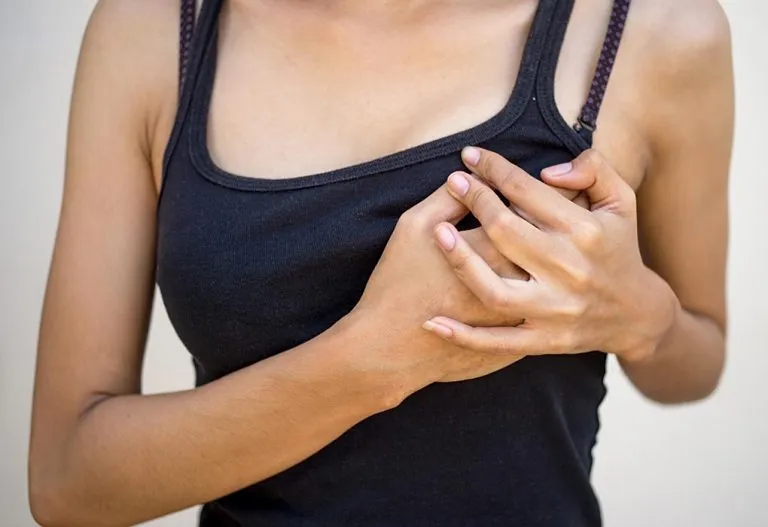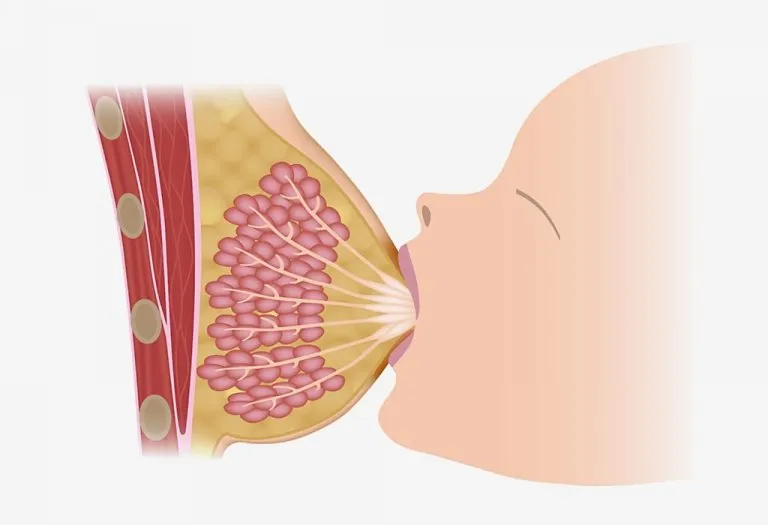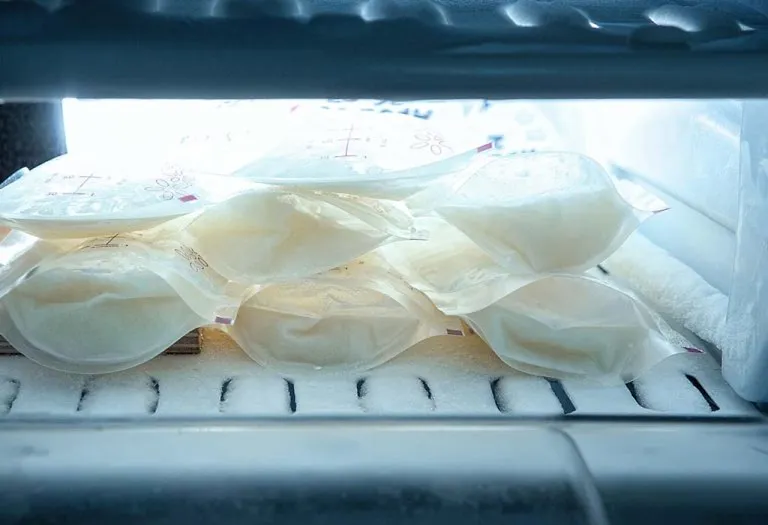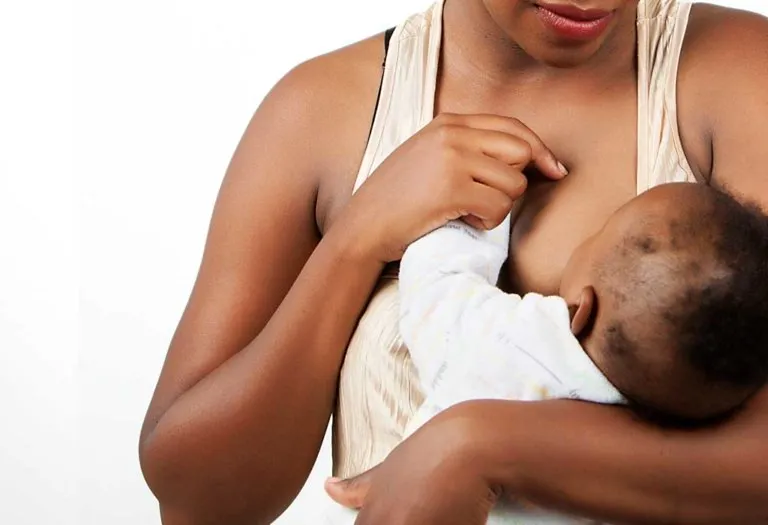Lump in Breast During Breastfeeding – Causes, Diagnosis and Treatment

- Is a Lump in Breast Normal While Breastfeeding?
- How to Recognise a Lump in Your Breast While Nursing?
- Causes of Breast Lump During Breastfeeding
- Tips to Follow If You Find a Breast Lump
- How Is a Breast Lump Diagnosed in Breastfeeding Mothers?
- Treatment for Breast Lumps While Breastfeeding
- How to Prevent Lumps in Breasts While Nursing?
- When to Consult the Doctor?
- FAQs
A lump in the breast is quite common in nursing mothers, but it should not be ignored in any case. After a few days of giving birth to your baby, your breasts may feel hard as they are engorged with breast milk. You may also feel lumps in breasts during breastfeeding, but these are mostly plugged milk ducts, which will go in a few days. However, if a lump does not go away in a week or two, you will need to see a doctor. There are many possible reasons for getting a lump in the breast, and of course, it will worry you, but if it is diagnosed at the right time, your life will be saved.
Is a Lump in Breast Normal While Breastfeeding?
A lump in the breast is common when you are nursing. It may be caused by different reasons, which can be treated or require no treatment. However, if you have a lump in your breast and it does not pain, then it could also be a sign of cancer but don’t panic. If the lump is painful and doesn’t reduce or vanish after breastfeeding, meet a Lactation Counsellor to check on your feeding position and Latch. If your mastitis symptoms persist for over three days, consulting a doctor to root it out is ideal (1).
How to Recognise a Lump in Your Breast While Nursing?
Breastfeeding can bring changes to your breasts, making it challenging to recognise abnormal lumps. Here’s how to recognise a lump in breast while nursing:
1. A Routine Self-Exams
Make it a habit to perform regular self-exams on your breasts. Familiarity with your normal breast texture will help you quickly notice any abnormal lumps or changes (8).
2. Observe for Visible Changes
Look for visible changes in your breasts, such as swelling, dimpling, or changes in size and shape. Stand in front of a mirror and inspect your breasts for any abnormalities in the skin or nipples. Visual changes may be a sign of a lump or other underlying issues (9).
3. Use Your Hands to Check for Lumps
Gently feel your breast tissue by moving your fingers in circular motions. Cover the entire breast and underarm area to check for any unusual lumps, hardness, or irregularities that may not be immediately obvious.
4. Assess Lump Texture and Movement
Examine how the lump feels—whether hard, soft, or rubbery. Also, check if it moves freely under the skin or feels fixed. A doctor should look at lumps that are firm and immobile.
5. Monitor for Any Unusual Pain
Pain or discomfort, especially after nursing, may signal an issue. Be cautious of lumps that cause continuous or sharp pain, which could indicate blocked ducts or infection (7).
6. Watch for Changes in Nursing Patterns
Changes in breastfeeding, such as reduced milk flow or your baby refusing to feed from one breast, may suggest a lump or blockage.
Causes of Breast Lump During Breastfeeding
Listed below are some of the types of breast lumps (2).
1. Plugged Ducts
If the milk gets blocked in one area of the breast, you may have plugged milk ducts. This could be because of improper latching due to an incorrect feeding position. Wearing a tight bra or tight clothes can also cause plugged ducts. Frequent use of a breast pump within a month of the child’s birth can also cause plugged ducts.
2. Engorged Breasts
At some point, most mothers may feel painful lumps in the breasts, which may be because of breast engorgement. It may lead to hard and swollen breasts and the engorged breasts may develop lumps. These lumps ease out once the milk is drained out manually or by a pump. This occurs when the baby is unable to suckle properly and as a result, the milk does not come. Overuse of galactagogues along with alternative top feed also leads to engorgement (5).
3. Mastitis
Mastitis is basically a lump or swelling in the breast accompanied by pain, redness, and tenderness. It is caused when a plugged duct goes untreated and the milk builds up behind the ducts and causes inflammation due to infection. It is usually accompanied by a fever (7).
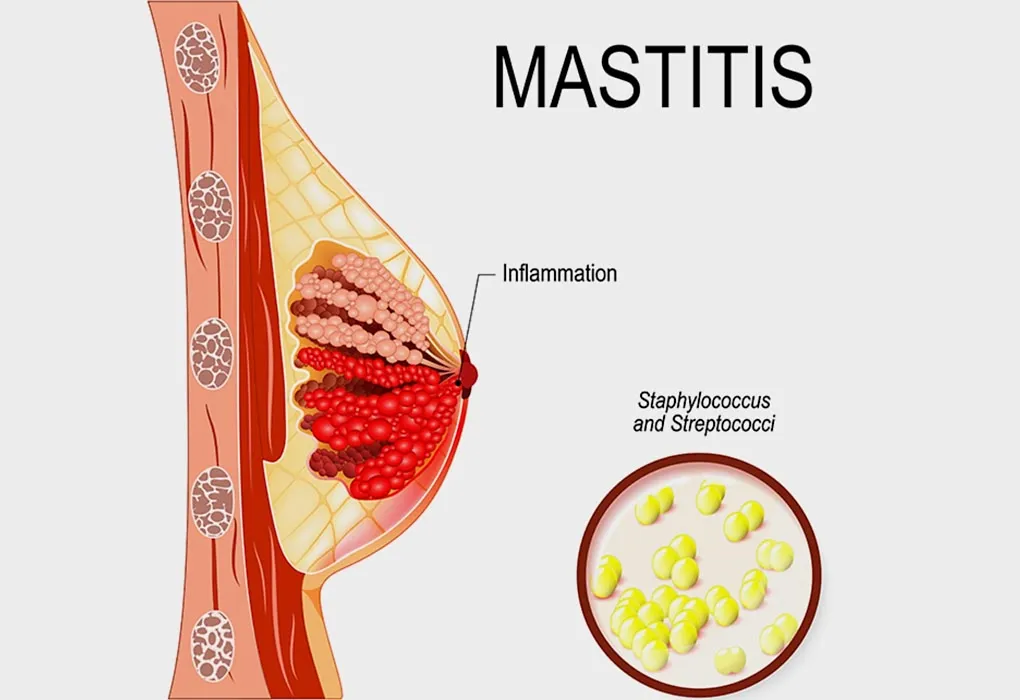
4. Breast Abscess
An abscess is formed due to pus in the breast. It usually occurs due to untreated or badly treated mastitis. It is necessary to drain out an abscess either by a needle or catheter aspiration along with antibiotics or it can lead to extreme pain and fever (3).
5. Galactoceles (Lacteal cyst or Milk cyst)
It is a cyst located near the mammary gland which retains milk or milk substances due to obstruction in the milk ducts. Usually, it does not cause any infection and goes away on its own once the mother stops nursing (6).
6. Fibroadenoma
It is a benign breast tumour and is more common in females between the ages of 15 and 30. It is a tumour of the gland and fibrous tissues. Unlike some breast lumps which come and go according to the monthly cycle, fibroadenoma does not disappear after the cycle. It rarely occurs in women in their postmenopausal stage (9).
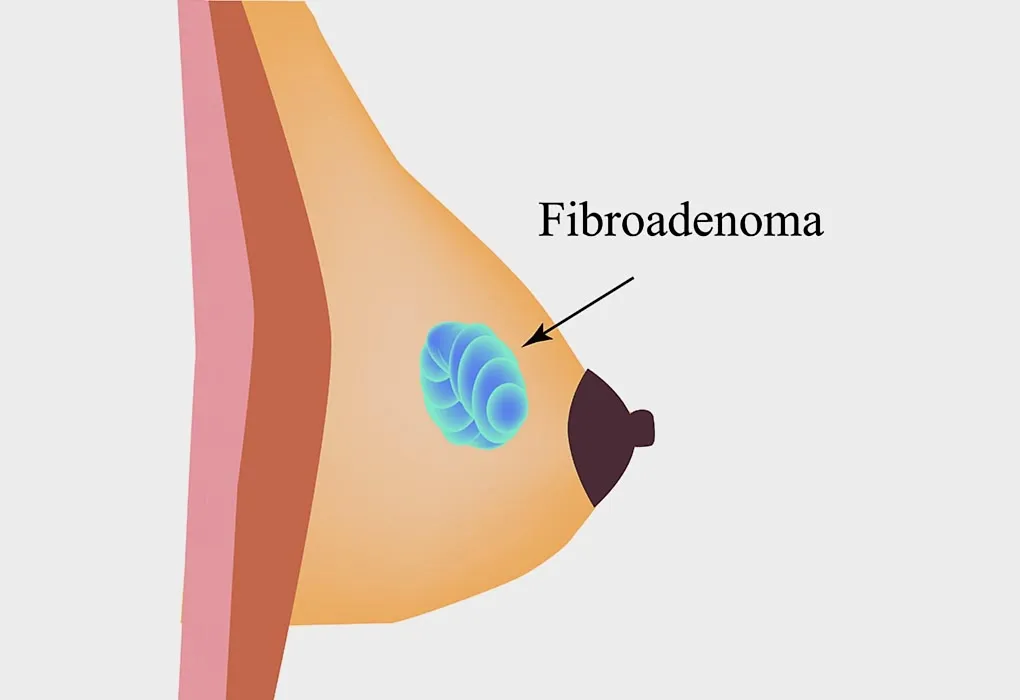
7. Lipomas
Lipomas are fatty lumps that grow slowly in breasts or any other region. They do not grow more than 2 cm in diameter. They are round or oval in shape, rubbery to feel, and may move easily with slight pressure. Such lumps can be more than one in number at one place.
8. Intraductal Papillomas
Intraductal papillomas are non-cancerous growth in the milk ducts of the breast. A solitary intraductal papilloma is a single tumour that grows in the large milk duct near the nipple. Some women have more than one and some may even experience bloody discharge from the growths.
9. Fat Necrosis
These lumps are a result of an injury to the fatty tissues in the breasts and require treatment if the condition persists for a long time. However, it is not dangerous and can be cured with the right treatment.
10. Breast Cancer
It is usually a hard or a firm lump usually causing no pain. It can originate either in the nipple or in the breast. However, it usually originates in the upper outer quadrant. Some large malignant tumours may compress the other parts of the breast or grow through the skin and can be very painful (4).
Tips to Follow If You Find a Breast Lump
It is important for women to self-examine their breasts for any lump, and if they find any, follow these tips to treat it as much as possible:
- If you are a nursing mother, the lump could be due to engorgement or plugged ducts. To treat it, you can take a warm bath in a bathtub, stand under a warm shower and let the water hit the breasts, or you may opt for a warm compress to unclog the lump just before nursing.
- After a warm bath or compress, massage the area of the lump and express the milk with your hands. When the lump is not hard after a massage, try to breastfeed the baby, else try to massage and hand express.
- Nurse your baby frequently as it will unclog your milk ducts and drain out the milk.
- Stay hydrated; drink lots of water, juices, and soups, especially if you have a temperature.
- Many times, lumps may occur due to tight bras. Therefore, wear a bra that provides good support but is not too tight. Also, avoid wearing underwire bras as they put pressure on the milk ducts.
- Check with a Lactation Counsellor on your feeding position and latch.
- If the lump does not subside in 3-4 days; if you see pus and blood in the milk; if there is discharge from the nipple, see a gynaecologist at the earliest.
- Get all the right tests done to rule out the malignancy of the lump.
- Figure out if the lump is a cyst or a tumour.
- In case it is a cyst, you do not require further investigation, and in case it is a tumour, have an autopsy done to find out whether it is benign or malignant.
- In case you learn it to be cancerous, don’t panic; do a bit of research to educate yourself on the treatment process. Also, talk to various people to know about the best doctors.
- When you visit an oncologist, feel free to ask all the questions you have.
- The last and the most important of all, relax and stay positive.

How Is a Breast Lump Diagnosed in Breastfeeding Mothers?
Listed below are the tests which are performed to diagnose lumps in the breast in breastfeeding mothers:
1. X-Ray
Doctors suggest an X-Ray to see through the breast tissue and other tissues like bones, lungs, etc., for any abnormality.
2. Ultrasound and CT Scan
A computed tomography scan (CT scan) is done to see if it is cancerous growth and to check whether cancer has moved to the chest walls or to other parts of the body.
3. Mammograms
It is the most effective test to detect breast cancer. This test can detect cancer even before the symptoms appear. A mammogram is done to check whether the breast lump is benign or cancerous. This is also an X-ray of the breast.
4. MRI
The test tells you whether the treatment is working on you or not by showing the progress of a tumour.
5. Fine Needle Aspiration
If earlier tests indicate breast cancer, then the doctor may ask for Fine Needle Aspiration Cytology in which some fluid is taken out from the affected area to look for cancer cells.
6. Stereotactic Core Biopsy
It is an alternative method of surgical biopsy and a less intrusive way to get the tissues required to detect cancer.
7. Surgical Biopsy
A surgical biopsy is done when the result of a needle biopsy is to be confirmed. Under local anaesthesia, a part of the lump or the entire lump is removed through a small opening.
Treatment for Breast Lumps While Breastfeeding
Not all breast lumps need treatment. Benign lumps like fibroadenoma do not need any remedy and cause no harm. Lumps caused due to injuries also subside when given time to heal.
Treatment options for lumps in the breast include:
1. Fine Needle Draining
Fine needle draining is a simple procedure and does not take much time. If there is an abscess or a cyst it will be drained with a fine needle.
2. Antibiotics
Lumps caused due to breast infections can be treated using antibiotics.
3. Lumpectomy
This is a treatment procedure to remove lumps surgically when they are cancerous.
4. Mastectomy
Mastectomy is performed in order to remove the cancerous breast tissue as a way to prevent breast cancer.
5. Chemotherapy
If the lump has been diagnosed as cancerous, then the doctor may suggest chemotherapy for the same. Depending on the stage of cancer, your doctor will suggest if you should go for chemotherapy or not.
6. Radiation
If the lump is cancerous, it can also be treated with radiation therapy where the patient has to undergo doses of radiation in accordance with the stage of cancer.
How to Prevent Lumps in Breasts While Nursing?
Here are some ways to prevent breast knot while breastfeeding:
- Try to breastfeed your baby On Demand with a proper latch.
- Dip your breasts in warm water for a few minutes, pat them dry with a clean cloth, and massage your breasts. If you feel a filled duct after nursing the baby, hand-express the duct and feed the expressed milk to your baby with a cup.
- Massage your breasts in a circular motion to prevent the milk from accumulating in one place.
When to Consult the Doctor?
It’s important to know when to consult a doctor if you discover a lump in breast feeding mother. Here are a few situations that should prompt you to seek medical advice (9):
- Lump persists after feeding
- The Lump feels hard or immobile
- Abnormal skin changes
- Pain or discomfort
- Changes in Milk Flow
- Fever or signs of infection
FAQs
1. Can breastfeeding continue with a lump?
In most cases, you can continue breastfeeding with a lump, which may help resolve the issue. Regular nursing helps clear blockages and maintain milk flow. However, if an infection or abscess is present, you should follow your doctor’s advice about whether to continue nursing from the affected breast.
2. How long does it take for a lump to resolve?
The duration for a lump to resolve varies based on the cause. Blocked ducts often clear up within a few days with regular breastfeeding, massage, and warm compresses. Infections like mastitis may take longer, especially if antibiotics are required.
Lumps in the breast while breastfeeding can be due to a number of reasons and not just breast cancer. Therefore, it is imperative to educate women that there is nothing to fear if they come across a lump in their breasts. Consulting a relevant expert for further guidance and support will help resolve the issue.
References/Resources:
1. Lumps and Mammograms; La Leche League International; https://llli.org/breastfeeding-info/lumps-and-mammograms/#
2. BREASTFEEDING: SOLVING EARLY PROBLEMS; Children’s Minnesota; https://www.childrensmn.org/educationmaterials/childrensmn/article/16076/breastfeeding-solving-early-problems/
3. Breast pain and breastfeeding; NHS; https://www.nhs.uk/conditions/baby/breastfeeding-and-bottle-feeding/breastfeeding-problems/breast-pain/
4. Breast cancer; World Health Organisation; https://www.who.int/news-room/fact-sheets/detail/breast-cancer?gad_source=1&gclid=EAIaIQobChMImKjv8er5iAMVKBSDAx0HWgBJEAMYASAAEgL9BvD_BwE
5. 5 common breastfeeding problems; UNICEF; https://www.unicef.org/parenting/food-nutrition/5-common-breastfeeding-problems?gad_source=1&gclid=EAIaIQobChMI5oPhgu35iAMVS6NmAh0p1ghxEAAYASAAEgIoBvD_BwE
6. Gada. P. B, Bakhshi. G; Galactocele; National Library of Medicine; https://www.ncbi.nlm.nih.gov/books/NBK578180/
7. Breastfeeding FAQs: Pain and Discomfort; Nemours KidsHealth;
https://kidshealth.org/en/parents/breastfeed-discomfort.html
8. Breast Self-Exam; National Breast Cancer Foundation; https://www.nationalbreastcancer.org/breast-self-exam/
9. Breast Lump; National Breast Cancer Foundation; https://www.nationalbreastcancer.org/breast-lump/
Also Read:
Breast Pain during Breastfeeding
Itchy Breast while Breastfeeding
Changes in Breast after Breastfeeding
Breast Compression during Breastfeeding
Tingling in Breast While Breastfeeding
Was This Article Helpful?
Parenting is a huge responsibility, for you as a caregiver, but also for us as a parenting content platform. We understand that and take our responsibility of creating credible content seriously. FirstCry Parenting articles are written and published only after extensive research using factually sound references to deliver quality content that is accurate, validated by experts, and completely reliable. To understand how we go about creating content that is credible, read our editorial policy here.







